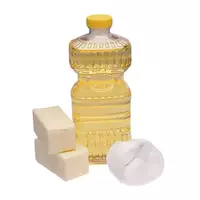Cooking fats

Cooking fats are nothing more than margarine or an oil suitable for consumption. According to the scientific definition, fats mean organic substances of natural origin, which are glycerol esters and fatty acids. Natural fats belong to the group of lipids that perform various functions in the human body. For example, it is fats of natural origin that act as an energy source, i. e. serve as a kind of battery for human oraganism.
Fats saturate the energy necessary for the normal course of all vital processes in the human body. Fats, along with proteins and carbohydrates, occupy the most important place in the human nutrition system. There are several varieties of natural fats that differ in structure and composition. For example, saturated, unsaturated, and also polyunsaturated fats or fatty compounds and acids occur in nature.
In addition to the above classification, fats are classified into food or culinary, vegetable or animal, as well as technical, i. e. compounds that are prohibited and even dangerous to eat. In turn, there are liquid and solid culinary fats, as well as oils. In addition, combijir, fryer fat or margoguselin are isolated. As a rule, natural fats are used in cooking, as well as in the pharmaceutical and cosmetic industries.
Technical fats are used as fuels and lubricants. It is worth noting that the production of culinary fats began to develop on the territory of the Russian Federation back in Soviet times. Food industry experts have set themselves the task of making a cheap type of cooking fats. Since then, cooking fats have been made, which, by the way, were distinguished by their low quality to put it mildly. Such a product did not appeal to consumers and was not popular. For this reason, the mandatory presence of cheap culinary fats in all culinary products was considered a characteristic feature of Soviet catering.
Cooking fat composition
The chemical composition of culinary fat, as well as taste, as well as consumer characteristics, depend primarily on the type of product. For example, the cooking fat may include a mixture of lard, vegetable oil, and food additives. In addition to cooking fat, the food industry uses separate subspecies of the product, namely confectionery or bakery fat.
The main material for the manufacture of culinary fats is salomas, which have the ability to melt at a temperature in the 60S, as well as melted fats of animal origin. Recently, nutritionists, as well as doctors, have been paying attention to the negative consequences of frequent consumption of food prepared using culinary fats. It is believed that food additives used in the product manufacturing process contribute to the development of cancer tumors.
897 kCal cooking fats
Energy value of culinary fats (Ratio of proteins, fats, carbohydrates - ju):
Proteins: 0 g (~ 0 kCal)
Fats: 99.7 g (~ 897 kCal)
Carbohydrates: 0 g (~ 0 kCal)
Energy ratio (b | y): 0% | 100% | 0%
 Español
Español Français
Français Português
Português Русский
Русский 简体中文
简体中文 繁體中文
繁體中文 日本語
日本語 한국어
한국어 العربية
العربية Türkçe
Türkçe Қазақ
Қазақ Deutsch
Deutsch Italiano
Italiano Українська
Українська
